Platform Changes |
| Modeled user interface |
The Eclipse platform user interface is now
represented internally as an EMF model. Applications can reconfigure or extend this
model to arrive at very different presentations of their application with no additional
coding required. Normalizing the workbench structure as a well defined model has
the added benefit of making the code for the workbench itself much simpler and less
error prone. Most importantly, this allows for very different workbench UI layouts,
such as parts living outside of perspectives, views and editors in dialogs, and other
designs not previously allowed by the older generation workbench with its rigid
hand-crafted model. Having a model also allows for more advanced tool support
for application designers, such as visual design tools. |
| Clean model structure |
The workbench model is separated into a number of different levels of building blocks. These are
sets of related model functionality that can be used to augment the basic capabilities of the RCP model
in order to enhance the UI. This allows RCP developers to choose the specific enhancements that they
really need rather than having to make an either/or choice between a model that is simplistic versus one
that can support the complete existing IDE UI. The categories are:
- Menus and Toolbars: This is a fairly generic definition, suitable for directly implemented operations.
- RCP: This is a Sash/Stack/Part containment model very much like the legacy one.
- Commands: This is the e4 version of the Commands/Handlers/Bindings infrastructure. Use this model if you
need more sophisticated operations like key bindings, retargetable commands (Undo, copy...).
- Trim: Using these elements allows clients to add trim containers on any side of their window and
populate them with ui elements.
- Editing: This is a specific element used to gain access to the legacy editor behavior.
- Shared Elements: These elements allow reuse of various model elements in different parts of the model.
It will be used in the compatibility layer for supporting the sharing of views and editor areas between
different perspectives.
|
| Pluggable presentation engine |
The workbench model is now translated into
concrete widgets via a generic presentation engine API. The platform
includes a default presentation engine that renders the model using traditional SWT
widgets, but applications can employ alternate presentation engines to render their
application model using a different widget toolkit. |
| Widget styling with CSS |
The workbench now defines a pluggable
styling engine that allows the appearance of widgets to be customized
declaratively using Cascading Style Sheets (CSS). Widget details such as fonts,
colors, borders, and icons can now be customized via application-defined CSS files.
This mechanism supports changing styles on the fly while the application is running.
The Eclipse SDK 4 includes styling data to implement the new IDE look and feel,
but rich client applications can employ different CSS styling to achieve a significantly
different widget appearance.
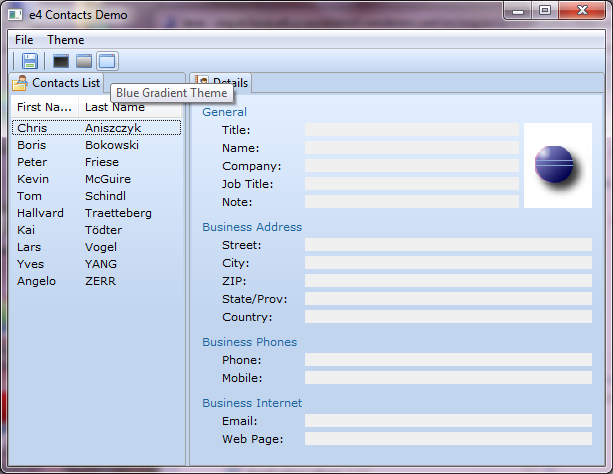
|
| Flexible tab rendering |
In the platform 3.6 release, SWT introduced API to allow a different renderer
for CTabFolder to be plugged in. The workbench now uses this pluggable
rendering to implement the new Eclipse 4 workbench look and feel.

|
| Hierarchical contexts |
The bundle org.eclipse.e4.core.contexts
introduces the notion of hierarchical contexts via the IEclipseContext API.
Contexts provide a mechanism for isolating application code from the framework,
providing an abstraction through which application code can obtain objects and
services from the framework. Contexts also provide a way for application code
to make data and services available to other application code in a loosely coupled manner.
Contexts currently support:
- Context hierarchies. Contexts can be nested within a parent context to override
services provided by their parent. This enables application code written in one context
to be easily transferred to work in different contexts.
- OSGi service lookup. Contexts can be used to obtain references to OSGi services.
The context takes care of tracking dynamic service changes and cleaning up unused
services when contexts are discarded.
- Dependency injection. Values from a context can be injected into an application object. This
results in injectable fields and methods in the application object being provided with
values defined in the context. Injection completely removes direct dependency from
application code onto the framework.
- Storage of functions. Contexts can store functions that are evaluated lazily
to obtain context values. A client retrieving values from a context may be obtaining
raw values stored in the context, or the result of some function that was evaluated
at the time of the context lookup.
- Traditional change notification, and registration of data-binding style update code with a context.
Each time the registered update code is run, the context tracks which context values
were referenced. Subsequent changes to any of those values will result in the update
code re-running. Updates and events are batched and queued to avoid superfluous
notifications.
|
| UI service lookup via contexts |
The workbench provides a hierarchy of service
contexts that reflects the widget hierarchy of the workbench itself. Thus when a
part obtains a service or data value from its context, it will correctly reflect the
widget containment structure of that part. This allows parts to be reused in
novel new widget layouts without requiring changes in the part's code. |
| javax.inject annotation support |
Context injection supports
the annotations defined in the upcoming javax.inject package.
Annotations such as @Inject and @Named can be used
to describe context elements to inject. The internal
injection processing has been updated to make use of these annotations, and
passes the open source annotation-based injection test suite found at
http://code.google.com/p/atinject/.
As a result of this work the dependency injection implementation is available
as an independent service. While the exact APIs are still under construction and will change,
we expect to make the javax.inject-based dependency injection available as one of
the core Eclipse 4 application platform services.
|
| Common event bus |
The Eclipse workbench now has an event bus style architecture based on the
publish/subscribe pattern. This means a 'one stop shopping' approach for
workbench clients; any user interface event we expect a client to be interested in
(UI model changes, part life-cycle events, etc) will be available through a
common mechanism simply by registering an event handler against the
appropriate topic.

|
| Git migration |
During this release cycle, the Eclipse and Equinox projects migrated their source control systems to Git.
The new Git repositories are now available for developers to clone or fork:
|
| Flexible viewer refactored |
The code driving the debug views (Debug, Variables and Breakpoints) has been substantially refactored to improve its overall quality, stability and
performance.
Some of the more notable changes include:
- There is a 30% improvement in the overall performance of the views
- Two new interfaces have been added to the provisional API:
IModelProxyFactory2 and ITreeModelViewer
- The Copy and Find actions have been re-written to work better with the virtual views
- A new viewer filter extension has been added to
TreeModelViewerFilter, mitigating scrollbar presentation issues
The complete list of changes can be found here.
|
| Refactored Eclipse 4 Event API |
Workbench UI events have been refactored to make them easier to understand and use.
For a detailed write up on the Eclipse 4 event model and the changes in this release
please take a look at http://wiki.eclipse.org/Eclipse4/RCP/Event_Model and
http://wiki.eclipse.org/Eclipse4/UI/Event/Migration.
|
| Trim styling |
In the new window trim implementation, the drag handle and the frame surrounding the trim are
defined through CSS. Here's an example of what this looks like:
.MToolControl.TrimStack {
frame-image: url(./winXPTSFrame.PNG);
handle-image: url(./winXPHandle.PNG);
frame-cuts: 5px 1px 5px 16px;
}
frame-image and handle-image define the images to be used to draw the frame.
The frame-cuts attribute is a set of 4 integer values that are used to divide the frame-image
into specific areas by defining two widths and two heights (the third is just the image size minus the
sum of the other two. This allows us to determine what part of the image to use for the top/right corner.
Here is a more interesting example that illustrates the power this gives to applications to customize their appearance:
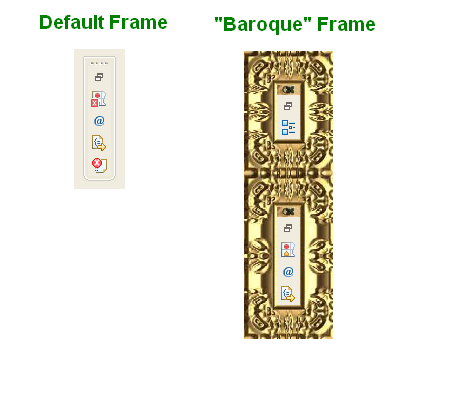
|
| CSS-based Theme changed event |
An OSGi EventAdmin-based event is now raised on theme change.
Subscribe to the IThemeEngine.Events.THEME_CHANGED topic to be notified when the workbench theme is changed.
|
| Changes to CSS extension points |
For those providing extensions for the new CSS support,
the extension points for providing property handlers and
element providers have been renamed to
org.eclipse.e4.ui.css.core.propertyHandler and
org.eclipse.e4.ui.css.core.elementProvider
(respectively).
|
| RelaunchLastAction has been made API |
The internal class RelaunchLastAction has been promoted to API and can be found in the
org.eclipse.debug.ui.actions package.
|
| Add new expression image constant has been made API |
The constant IDebugUIConstants.IMG_OBJ_ADD_NEW_EXPRESSION has been added to API to allow consumers who
extend or use the Expressions view look-and-feel to use the Add New Expression icon
( ). ).
|
| Toggle breakpoints target manager has been made API |
The interface org.eclipse.debug.ui.actions.IToggleBreakpointsTargetManager has been made API to allow clients
access to known IToggleBreakpointTargets. The new API can be accessed via
org.eclipse.debug.ui.DebugUITools#getToggleBreakpointsTargetManager()
|
| BreakpointTypesContribution has been made API |
The class org.eclipse.debug.ui.actions.BreakpointTypesContribution has been added to API. This class
can be reused by clients to add a breakpoint type action in the editor gutter context menu to match the action(s) that appear in the
Run > Breakpoint Types menu.
|
| Find action can be customised in Variables View specialisations |
Consumer now have the ability to completely override the behaviour of the Find... action in the Variables View and any of
its sub-classes, e.g. Expressions View, Modules View, etc.
To replace the default Find... actions clients must provide an adapter for the
interface org.eclipse.debug.internal.ui.viewers.model.provisional.IViewActionProvider.
For more information see the Javadoc for org.eclipse.debug.internal.ui.viewers.model.provisional.IViewActionProvider
with an example available in the org.eclipse.debug.examples.ui bundle found in the Platform Debug Git repo.
|
Equinox Changes |
| New OSGi console |
This release includes a brand new OSGi console based on the Apache Felix Gogo project.
In previous releases the Equinox framework contained a built-in OSGi console.
This console allows you to interact with the OSGi framework and execute commands
on the running instance of the framework. For example, it can be used to install bundles
or to get a list of currently installed bundles. The built-in console is convenient because
it is always available without needing to install extra bundles, but it is also limited
because the framework itself must contain all the functionality of the built-in console.
The Apache Felix Gogo project has developed an advanced shell for interacting with OSGi frameworks.
Instead of continually enhancing the built-in Equinox Framework console, a new external Equinox
Console bundle has been created that uses the Apache Felix Gogo bundles. The new Equinox Console
bundle continues to provide support for the Equinox Console APIs (package
org.eclipse.osgi.framework.console). It also adds many new enhancements which are
possible through the use of the Gogo shell. This includes features such as tab completion,
command history, piping, grep, telnet and ssh connections, and more. Type help on the console
to see a list of available commands, or help <command-name> for information on
how to use each command.
|
| Update to Jetty 8 and Servlet 3.0 |
The Equinox HTTP service implementation is now using Jetty 8 as the
web container to support Servlet 3.0 and JSP 2.2. The Equinox HTTP
service is required to host the Eclipse user assistence web context
for serving up help content.
For the Juno release, Equinox will no longer support the use of older
Jetty implementations and we are no longer shipping Jetty 6. The
Equinox HTTP service implementation will no longer work with the
Servlet 2.5 and JSP 2.1 APIs. Also note that the
Jasper and expresson language implementation bundles
have changed in order to support the Servlet 3.0 and JSP 2.2
specifications. The following bundles have been removed:
- org.apache.jasper
- org.apache.commons.el
- org.mortbay.jetty.server
- org.mortbay.jetty.util
These have been replaced with the following to support Servlet 3.0
and JSP 2.2:
- org.eclipse.jetty.continuation
- org.eclipse.jetty.http
- org.eclipse.jetty.io
- org.eclipse.jetty.security
- org.eclipse.jetty.server
- org.eclipse.jetty.servlet
- org.eclipse.jetty.util
- javax.el
- org.apache.jasper.glassfish
- com.sun.el
|
| Customize storage for preference scopes |
When defining your own preference scope, you can now extend a simple storage
customization class rather than implementing all the preference logic yourself. In this class you
simply define the code to read and write a preference node to whatever backing store you want to use.
This makes it very easy to define a custom preference scope with alternate storage
requirements. For more details see the documentation for the org.eclipse.equinox.preferences.preferences
extension point, or the new API class org.eclipse.core.runtime.preferences.AbstractPreferenceStorage.
|
| OSGi Core Release 5 |
With this release the Equinox OSGi Framework implements the
draft OSGi Core Release 5 (R5) specification. The OSGi Core
R5 specification is an incremental change from the R4.3
specification. A majority of the changes included in
the Core R5 specification are in support of the upcoming
OSGi Enterprise Release 5 specification. A public draft of
the specification will be available
here
by March 26, 2012. The final version will be available
here
shortly after that.
|
| Publisher Support for Negation Requirements |
The p2 publisher can now publish negation requirements.
A negation requirement is a requirement that must not
be present. For example, the Rich Ajax Platform (RAP) can
declare a negation requirement on the Eclipse Platform, meaning
that RAP won't be installable into your IDE.
Negation requirements are specified using the p2.inf file.
Details are available on the Wiki
|
SWT Changes |
| Highlight TrayItem Image |
You can now provide a custom image for use as the hightlight image for
a tray item on Cocoa. The highlight image is shown when the tray item is activated.
The default tray item image will be restored when the tray item is deactivated.
Default Tray Item
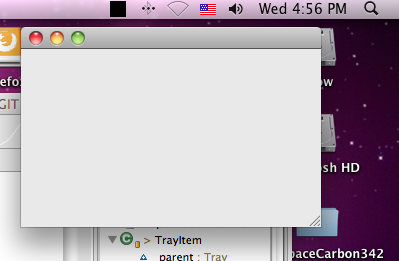
Highlighted Tray Item

|
| Added support in StyledText to show the scrollbars only when needed |
In the past, when a StyledText was created with scrollbars it would show
them all the time, even when the client area was big enough to show the entire content.
By using setAlwaysShowScrollBars() this behaviour can now be configured so that
instead of showing a disabled scrollbar, the StyledText will only display the scrollbar when needed.
|
| Event type constants in StyledText are now public |
The following event type constants in StyledText have been made public:
- ExtendedModify
- LineGetBackground
- LineGetStyle
- TextChanging
- TextSet
- VerifyKey
- TextChanged
- LineGetSegments
- PaintObject
- WordNext
- WordPrevious
- CaretMoved
This allows these constants to be used with Widget#isListening() to verify if a
listener handler was added for any event type in StyledText.
|
| Default Browser renderer is now configurable |
The native renderer that is used for SWT.NONE-style browsers can now be
configured by setting a Java property. This is particularly important for applications
that create browsers with a specific native renderer style (eg.- SWT.MOZILLA),
in order to avoid conflicts that can occur when multiple native renderers are loaded in
the same process.
For more information on using this new property see
How do I specify the
default type of native renderer that is used by the Browser? .
|
| FontDialog Effects |
New API has been added to FontDialog to prevent the user from selecting font effects,
such as color, underline, strikethrough and shadow.

|
| New Combo API |
Two new APIs have been added to Combo that allow users to get the caret information
in a combo box. Combo.getCaretLocation returns the pixel coordinates of the
caret. Combo.getCaretPosition returns the character position of the caret.
For an example of how to use this API see
Snippet 359.
|
| Tree Cursor |
The new TreeCursor class can be used to enable users to navigate a Tree control's individual
cells, similar to what TableCursor makes possible for Table controls. For an example of
using TreeCursor see Snippet360.
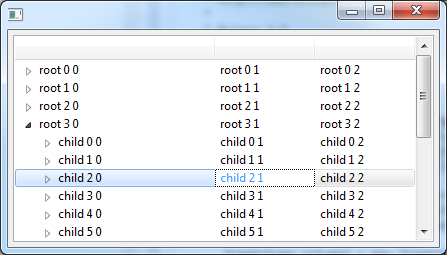
|
| XULRunner 10 |
The SWT browser now supports embedding XULRunner 10.0.x (note that XULRunner versions 4.x - 9.x are not supported).
Apps wishing to use this must ship a XULRunner 10 runtime and explicitly point at it as described in
the FAQ .
|
| Set/get custom colors in ColorDialog |
ColorDialog now supports getRGBs() and setRGBs(RGB []) to allow applications
to retrieve, save, and restore any custom colors that the user selected in the dialog.
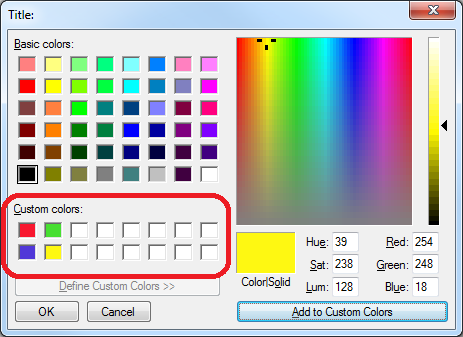
|
| BIDI segments on text widget |
The Text widget now supports adding SegmentListener for BIDI support. This allows BIDI ordering to be applied to segments of the text instead of the entire text.
|
| Browser Function Access |
BrowserFunction can now be installed into specific frames.
|
| SWT Runtime introspection |
SWT.isLoadable() can be used to determine whether the SWT implementation can be loaded in the current running environment.
|
| Overlay scrollbars |
Scrollable.getScrollbarsMode() can be used to determine whether the platform shows overlay scrollbars.
|




 ).
).




